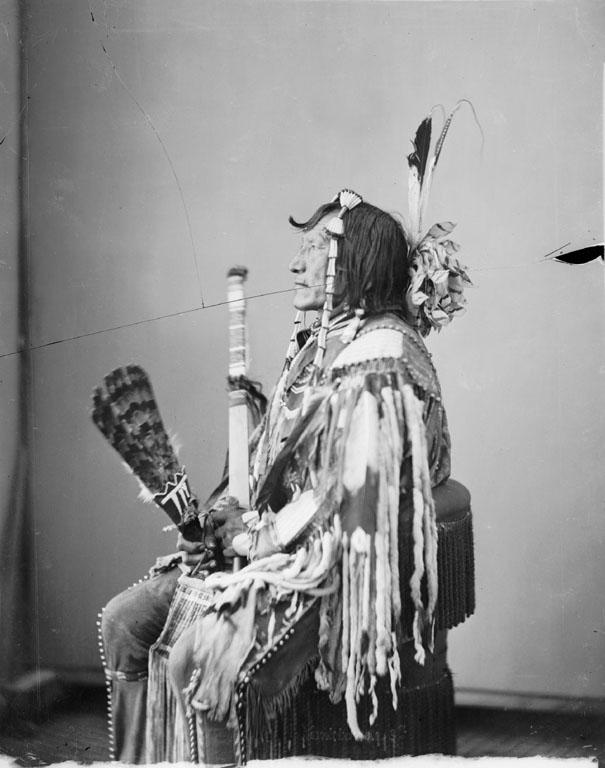Two
Bears, who was photographed by Gardner in 1872. He had a
son called Two Bears, Young Two Bears or Two Bears II, who
later was also a leader at Standing Rock. —Dietmar
Schulte-Möhring

He
was a leader of the Lower Yanktonai division that settled
at Standing Rock. Josephine Waggoner (mss, Museum of the
Fur Trade) states that he belonged to the Ite-gu (Burnt
Face) band. In the Lower Yanktonai camp-circle listed by
Dorsey the Ite-gu is the sixth (of seven) bands, no. 1 being
at the south side of the entrance to the hoop - i.e. Ite-gu
is in the northeast segment of the circle.
See
Walker, one of Two Bears' brothers, is mentioned in the
A. B. Welch papers as being one of the "eagle parents"
(wambdi hunka) of the band - explained as the leaders who
walked at the head of the tribal column and organized camp
removals. In other words like the Teton wakichunze or Deciders.
The term with its connection to Upper World symbolism hints
at a greater ritualism among the Yankton-Yanktonai in these
matters than among the Teton (maybe because as the latter
got more horses the buffalo hunting economy became more
secure?). According to Ella Deloria the Yankton Deciders
(four in number) lived in the council tipi for the term
of their office, sleeping in a cross-formation centered
on the fireplace. This is Four Quarters symbolism of course.
The
winter counts of Blue Thunder and No Two Horns note the
death of Two Bears under winter 1878-79 - and the death
of a brother called Three Thighs under 1886-87. —
Kingsley Bray
Two
Bears´ father was Standing Growling Bear and his Mother
was Invisible Walking Woman. His brother-White Eagle, Two
Bear II, White Bird, Wounded Hand, See Walker, Looking Raven,
Sisters- Winona, Feather Woman, Red Woman, Earth Walking
Woman, Going lodge woman.
He was in the Whitestone Massacre in the James River Valley,
It was his band who first took in Inkpaduta and his family.
At the Whitestone massacre, all that was in the camp with
the Ihunktonwan people was Inkpaduta's wives and two children,
both lived though the massacres. Inkpaduta travel to the
Grand River right before the massacre.
The massacre wiped out 300 people under Two Bears and all
their food and homes were burned. Many were taken to prison
as prisoner of war. It divided the nation where today the
people reside on the Standing Rock Sioux Tribe, Spirit Lake
Sioux Tribe, Fort Peck Sioux Tribe, Crow Creek Sioux Tribe
and Sioux Valley, Mantoba. Many joined With Sitting Bull's
band and fough in the Little Big Horn Battle.
My
great great Mary Moccasin was a young girl at Whitestone.
She was shot in the hip and survived. The stories of the
massacres have been past down though my family. In her old
age she would wake up screaming and talk about the soldier
that were shooting down our people. —
LaDonna Brave Bull Allard

From
an article by Michèle T. Butts © 2005 by Michèle
Butts:
. . . the First U.S. Volunteers actively pursued the seemingly
illusive goal of negotiating a peace agreement with the
Lakotas and Upper Yanktonai. Their chief ally in this
endeavor was the Yanktonai chief, Two Bears, whom Sully
had convinced at Whitestone Hill in 1863 that peace was
preferable to war. The short stocky leader with fierce,
piercing eyes was very influential and very brave to venture
into any sort of relationship with the strange aliens
who were invading his homeland. (...) Although Dimon was
not as convinced as Sully of the chief's loyalty, the
young colonel obediently depended upon Two Bears as his
main intermediary and informer among the Sioux. Sending
his sons and other spies into camps upriver, Two Bears
kept Dimon informed regarding the visits of anti-American
Métí traders, raids being planned, and other
intelligence. Upon Two Bears' assurance that Dimon was
in earnest, Yanktonai Chief Black Catfish agreed in October
1864 to join Two Bears' camp of peace-seeking Sioux, trusting
that the colonel would protect and be kind to his people.
Over the coming year, several hundred Native Americans
joined this peace faction of 150 lodges and proved to
be loyal allies against war parties. Dimon invited Natives
camped within a 40-mile radius to the post's Christmas
feast and Fourth of July Celebration.When Sully arrived
in July 1865, nearly a thousand Native people were gathered
to talk peace with him.
http://www.archives.gov/publications/prologue/2005/winter/galvanized.html

—Dietmar Schulte-Möhring